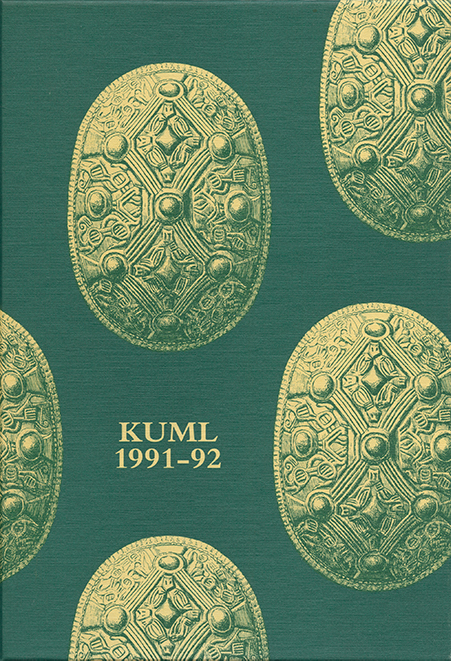The method of production of Viking Age tortoise brooches
DOI:
https://doi.org/10.7146/kuml.v38i38.111331Keywords:
Method of production, production, viking age, tortoise broochesAbstract
The method of production of Viking Age tortoise brooches
All the hitherto proposed theories on the production of tortoise brooches lack practical trials to show whether they lead to the desired results. Also there are errors and deficiencies in all the theories set forth. For instance several theories postulate the use of older brooches for pressing into clay, but fail to explain how the older brooches were made. A mould can be made either with the help of a model which is removed again after being pressed into the loam, or of a model which is melted out. An obvious material that can be melted out is beeswax. As beeswax shrinks 4-5% when it congeals, the wax copies are released naturally from the master mould.
All researchers have overlooked the shrinking of materials during solidification and drying. The shrinkage of beeswax, loam and metal is about 6%. This very considerable reduction of size is not reflected in the surviving brooches, and it is therefore unlikely that older brooches were used directly as masters. The perforations in the upper shells of double shelled brooches can be seen as direct impressions of projections on the master mould. If the perforations in the upper shells of matching pairs are compared, they are found to be so similar in general shape and position that the shells can be orientated together. The models for the upper shells must therefore have been cast in the same master mould. The purpose of the textile muse be to determine the body thickness. The commonest method of production probably had the following stages:
1) preparation of a master
2) making the master mould
3) production of wax copies in the master mould and final finishing work on them
4) making the moulds
5) firing the moulds and casting
6) finishing work
To use the textile method to prepare very similar but not completely identical tortoise brooches, a solid master is needed of beeswax. With this is made a master mould for the casting of wax models. After the wax models have hardened arid been removed from the master mould, the ornamental details are cut freehand.
Loam is applied to the upper surface of the individual wax models in several coatings to give a total thickness of c. 1,5 cm. The reason for application in several coatings is to reduce the risk of drying cracks. When each mould is dry, the wax copy is melted out. Guide notches and a (half) sprue is cut in their edge.
Projections for pinholder and catchplate are made in wax and affixed by heating to the negative inner side of the upper mould. A piece of cloth is dipped in melted wax to make it sufficiently rigid when later placed in the concavity of the upper mould. Before it is assembled, slits are cut in it so they correspond with the wax projections tint have been mentioned.
A solid model of the sprue is fitted in the previously cut half sprue. Then the lower mould can be made in one piece having about the same thickness as the upper mould.
When the mould is completely dry, it is heated until the wax melts (the melted wax is absorbed by the dry modelling clay), after which the two half moulds can be separated and the piece of cloth removed.
After the cloth have been removed and the two half moulds fitted together, the opening between them is blocked with a strip of loam, that is spread over the two halves to prevent the metal from being lost along the join, and to hold the two halves together. When the mould is completely dry it must be fired. When the firing is completed and the mould has reached its optimal temperature, the metal must be melted and reach its required temperature. After that the melted metal is poured into the mould, which should remain on the fire until the metal has solidified and lost its red colour. The further cooling process is done using water. When the mould is cold it can be broken and the casting released. The whole finishing process still remains to be done.
The working time for making a master of beeswax and a master mould of clay for a fibula of type J. P. 37 was c. 20 hours. The remaining preparation of the model, the making of moulds, their firing, together with casting the metal, finishing, and assembling took c. 55 hours. With practice the working time could be reduced, but a considerable investment of labour still goes into making a pair of brooches of average quality, for which reason it can be supposed that ornaments of this type were status symbols.
Bjarne Lønborg
Downloads
Published
How to Cite
Issue
Section
License
Fra og med årgang 2022 er artikler udgivet i Kuml med en licens fra Creative Commons (CC BY-NC-SA 4.0).
Alle tidligere årgange af tidsskriftet er ikke udgivet med en licens fra Creative Commons.


